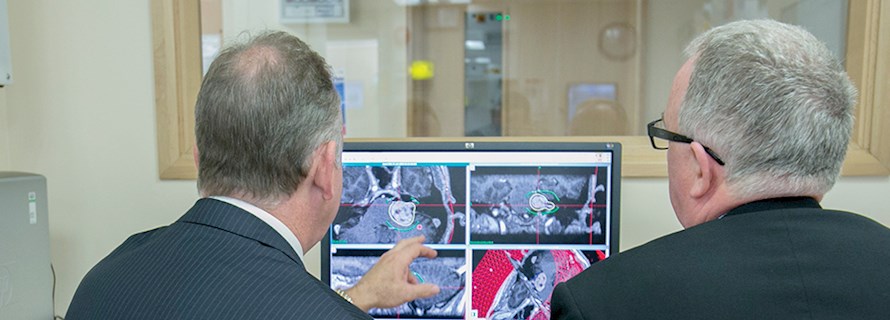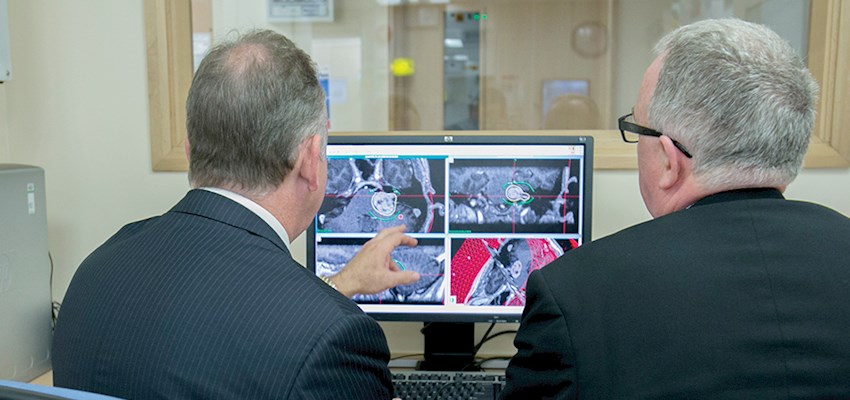Metastatic brain tumour
Intracranial Secondary tumours
Metastatic (or secondary) brain tumours develop when cancerous cells in another part of the body spread to the brain
About brain metatases
Also called cerebral secondary brain tumours and brain metastases, metastatic brain tumours form when the cells of a primary cancer in another part of the body spread to the brain. Any cancer can metastasise (spread) to the brain but lung, skin, breast, colon and kidney cancer tend to be the main ones.
Brain metastases are the most common form of tumour in the brain. It is estimated that 20% to 40% of all patients diagnosed with cancer will develop secondary cancer in the brain, the most common types of cancers that result in secondary tumour of the brain are lung cancer, breast cancer, malignant melanoma, kidney cancer and colon cancer (in decreasing order of frequency).
The good news is, there are effective treatments that offer new hope and make it possible to experience a consistent and uncompromised quality of life.The number of patients who receive treatment for brain metastases is increasing every year. This is due to the many improvements in detection, diagnosis and treatment, and to the fact that patients live longer with their primary cancer.
Need to know
-
Symptoms of metastatic brain tumours icon plus
Your symptoms will often depend on the size, location and rate of growth of the metastatic brain tumour. Generally speaking, they might include
- headaches possibly with nausea and vomiting
- mental or memory problems
- dizziness
- seizures
- weakness or numbness on one side of your body or face
-
Diagnosis icon plus
If your oncologist or neurosurgeon thinks you may have a metastatic brain tumour, they may recommend further tests.
- A neurological examination. This involves checking a number of things, like your vision and balance, to find out which part of your brain may be affected.
- CT, MRI and PET scans. These imaging scans produce detailed images of your brain, helping us to spot tumours.
- Biopsy. This is a surgical procedure to collect a small sample (biopsy) of the tumour. The sample is then looked at under a microscope to find out if is cancerous.
-
Potential treatment options icon plus
If you've been diagnosed with a metastatic brain tumour, your oncologist or neurosurgeon will explain your treatment options to you. These might include:
- High-doses of corticosteroid medicine to reduce swelling around the tumour.
- Radiosurgery (Gamma knife or CyberKnife) if the tumour is suitable. This destroys the tumour without the need for open surgery
- Surgery to remove as much of the brain tumour as possible (if it's necessary and relatively safe to do so).
- Standard radiation therapy to destroy tumour cells using high energy X-ray beams in daily sessions over a 3 week course of treatment.
Brain tumours can affect your vision, motor, speech and thinking skills. At HCA UK, we offer comprehensive rehabilitation therapy services, including occupational therapy, physiotherapy and speech therapy to help you manage the effects of brain tumours.
-
Side effects icon plus
In Gamma Knife treatment side effects are rare. For example, the risk of brain injury leading to problems with memory and concentration is lower with radiosurgery than with Whole Brain Radiation Therapy (WBRT).
More than
250,000 patients
with brain metastases have been treated with Gamma Knife radiosurgery worldwide.
Treating brain metastases with Gamma Knife technology
Gamma Knife surgery doesn’t require an incision or the hair to be shaved before the treatment. The key to the success of Gamma Knife radiosurgery is its unique ability to precisely deliver many individual beams of high intensity radiation, targeting even the smallest tumour with sub-millimetre precision. Each beam has a relatively low energy, so the radiation has virtually no effect on the healthy brain tissue it passes through.
At the focal point, however, all the beams converge to deliver a high dose of radiation that kills the cancer cells, even in deep-seated tumours with irregular shapes. Gamma Knife radiosurgery may be used as the primary treatment method or as a boost or adjunct to other treatments, such as WBRT or surgery.




Studies that examine the effectiveness of Gamma Knife radiosurgery show for any brain location on average
exceeds 85%
success rate for local tumour control rates – in which a specific tumour stops growing.
Our neurosurgery consultants




Our neurosurgical facilities
From complex surgery to straightforward procedures, we provide exceptional care across our network of hospitals, outpatient centres and specialist clinics.
-
The London Gamma Knife Centre
Platinum Medical Centre
15 - 17 Lodge Road, St John's Wood
London NW8 7JA
Book an appointment
Our team can help with any enquiries or you can make an appointment with one of our experienced consultants.
Call us today
020 7079 4344